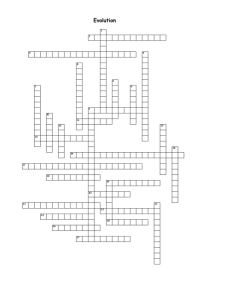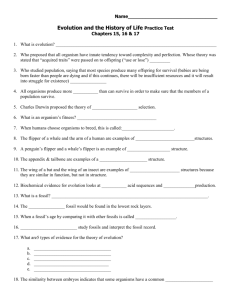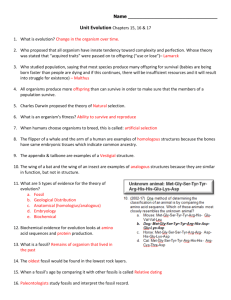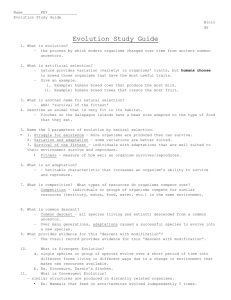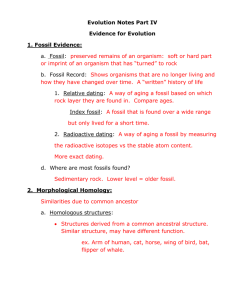Advanced Biology
advertisement
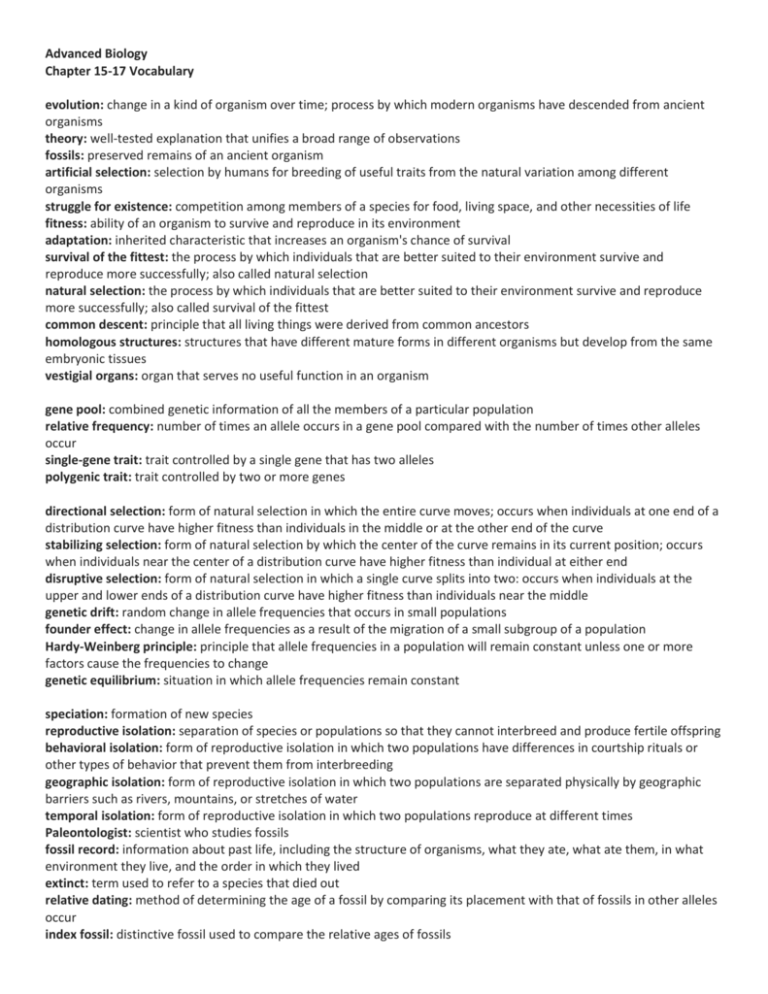
Advanced Biology Chapter 15-17 Vocabulary evolution: change in a kind of organism over time; process by which modern organisms have descended from ancient organisms theory: well-tested explanation that unifies a broad range of observations fossils: preserved remains of an ancient organism artificial selection: selection by humans for breeding of useful traits from the natural variation among different organisms struggle for existence: competition among members of a species for food, living space, and other necessities of life fitness: ability of an organism to survive and reproduce in its environment adaptation: inherited characteristic that increases an organism's chance of survival survival of the fittest: the process by which individuals that are better suited to their environment survive and reproduce more successfully; also called natural selection natural selection: the process by which individuals that are better suited to their environment survive and reproduce more successfully; also called survival of the fittest common descent: principle that all living things were derived from common ancestors homologous structures: structures that have different mature forms in different organisms but develop from the same embryonic tissues vestigial organs: organ that serves no useful function in an organism gene pool: combined genetic information of all the members of a particular population relative frequency: number of times an allele occurs in a gene pool compared with the number of times other alleles occur single-gene trait: trait controlled by a single gene that has two alleles polygenic trait: trait controlled by two or more genes directional selection: form of natural selection in which the entire curve moves; occurs when individuals at one end of a distribution curve have higher fitness than individuals in the middle or at the other end of the curve stabilizing selection: form of natural selection by which the center of the curve remains in its current position; occurs when individuals near the center of a distribution curve have higher fitness than individual at either end disruptive selection: form of natural selection in which a single curve splits into two: occurs when individuals at the upper and lower ends of a distribution curve have higher fitness than individuals near the middle genetic drift: random change in allele frequencies that occurs in small populations founder effect: change in allele frequencies as a result of the migration of a small subgroup of a population Hardy-Weinberg principle: principle that allele frequencies in a population will remain constant unless one or more factors cause the frequencies to change genetic equilibrium: situation in which allele frequencies remain constant speciation: formation of new species reproductive isolation: separation of species or populations so that they cannot interbreed and produce fertile offspring behavioral isolation: form of reproductive isolation in which two populations have differences in courtship rituals or other types of behavior that prevent them from interbreeding geographic isolation: form of reproductive isolation in which two populations are separated physically by geographic barriers such as rivers, mountains, or stretches of water temporal isolation: form of reproductive isolation in which two populations reproduce at different times Paleontologist: scientist who studies fossils fossil record: information about past life, including the structure of organisms, what they ate, what ate them, in what environment they live, and the order in which they lived extinct: term used to refer to a species that died out relative dating: method of determining the age of a fossil by comparing its placement with that of fossils in other alleles occur index fossil: distinctive fossil used to compare the relative ages of fossils half-life: length of time required for half of the radioactive atoms in a sample to decay radioactive dating: technique in which scientists calculate the age of a sample based on the amount of remaining radioactive isotopes it contains geologic time scale: scale used by paleontologists to represent evolutionary time era: one of several subdivisions of the time between the Precambrian and the present period: unit of time into which eras are subdivided proteinoid microsphere: tiny bubble, formed of large organic molecules, that has some characteristics of a cell. microfossil: microscopic fossil endosymbiotic theory: theory that eukaryotic cells formed from a symbiosis among several different prokaryotic organisms mass extinction: event in which many types of living things become extinct at the same time macroevolution: large-scale evolutionary changes that take place over long period of time adaptive radiation: process by which a single species on small group of species evolves into several different forms that live in different ways; rapid growth in the diversity of a group of organisms convergent evolution: process by which unrelated organisms independently evolve similarities when adapting to similar environments coevolution: process by which two species evolve in response to changes in each other punctuated equilibrium: pattern of evolution in which long stable periods are interrupted by brief periods of more rapid change
